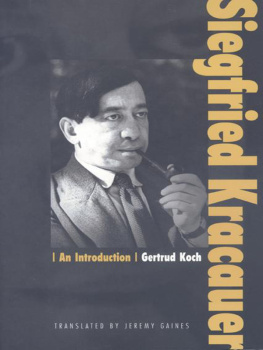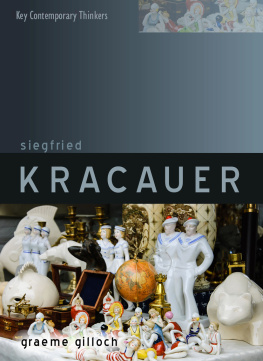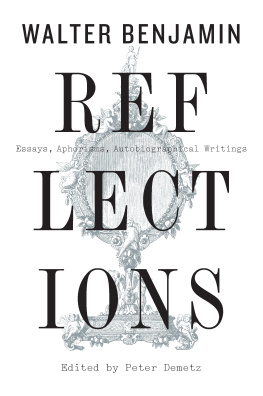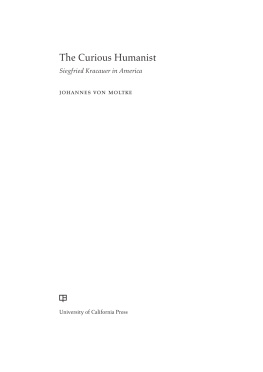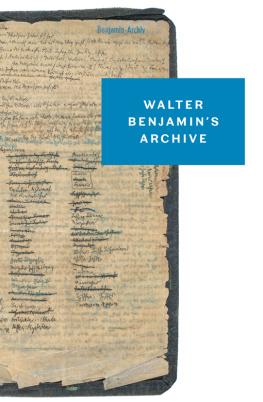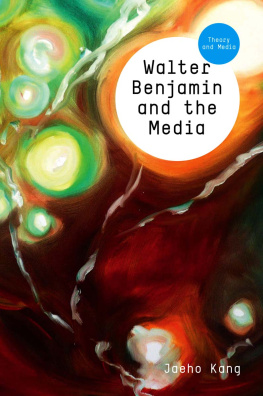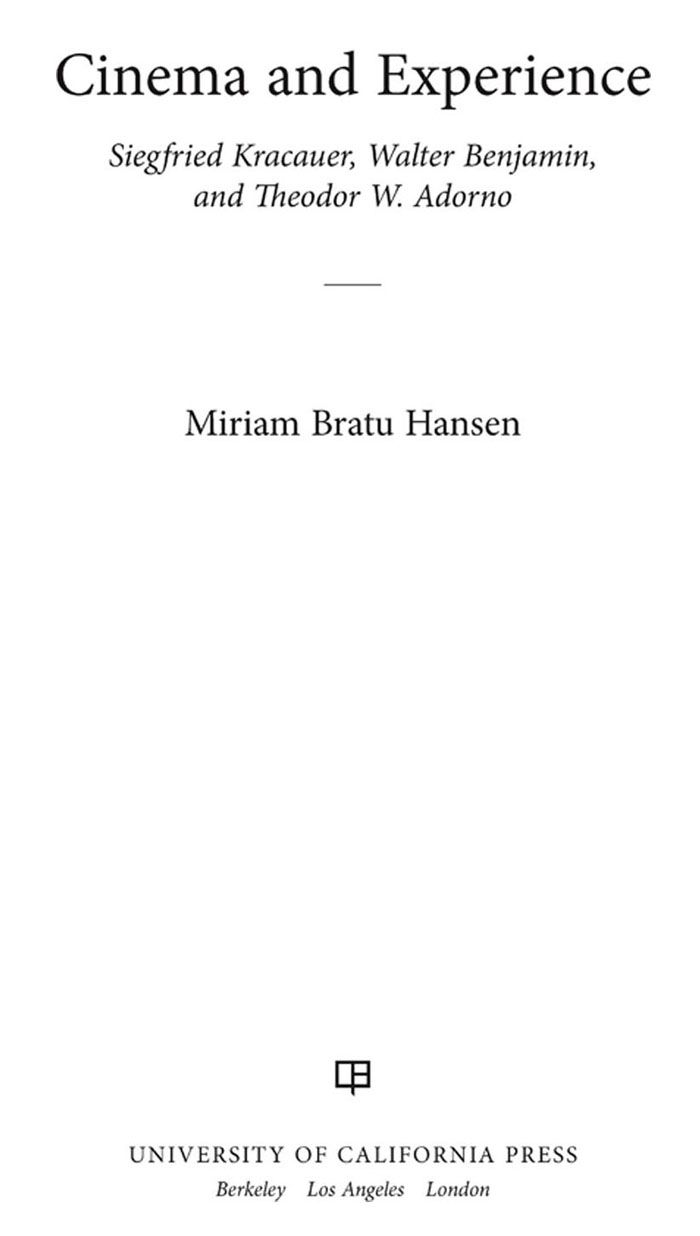Cinema and Experience
WEIMAR AND NOW: GERMAN CULTURAL CRITICISM
Edward Dimendberg, Martin Jay, and Anton Kaes, General Editors
Cinema and Experience
Siegfried Kracauer, Walter Benjamin, and Theodor W. Adorno
Miriam Bratu Hansen

University of California Press, one of the most distinguished university presses in the United States, enriches lives around the world by advancing scholarship in the humanities, social sciences, and natural sciences. Its activities are supported by the UC Press Foundation and by philanthropic contributions from individuals and institutions. For more information, visit www.ucpress.edu.
University of California Press
Berkeley and Los Angeles, California
University of California Press, Ltd.
London, England
2012 by The Regents of the University of California
Library of Congress Cataloging-in-Publication Data
Hansen, Marian Bratu, 19492011.
Cinema and experience : Siegfried Kracauer, Walter Benjamin, and Theodor W. Adorno / Miriam Bratu Hansen.
p. cm.(Weimar and now: German cultural criticism ; 44)
Includes bibliographical references and index.
ISBN 978-0-520-26559-2 (cloth : alk. paper)
ISBN 978-0-520-26560-8 (pbk. : alk. paper)
1. Motion pictures. 2. Kracauer, Siegfried, 18891966Criticism and interpretation. 3. Benjamin, Walter, 18921940Criticism and interpretation. 4. Adorno, Theodor W., 19031969Criticism and interpretation. I. Title.
PN1994.H265 2012
791.4309dc23 2011017754
Manufactured in the United States of America
20 19 18 17 16 15 14 13 12
10 9 8 7 6 5 4 3 2 1
In keeping with a commitment to support environmentally responsible and sustainable printing practices, UC Press has printed this book on Rolland Enviro100, a 100 percent postconsumer fiber paper that is FSC certified, deinked, processed chlorine-free, and manufactured with renewable biogas energy. It is acid-free and EcoLogo certified.
For Michael Geyer
In memory of Karsten Witte (19441995)
CONTENTS
PREFACE
The question of how to engage a living thought that is no longer historically current, raised by Fredric Jameson with regard to Theodor W. Adorno, has a particular urgency when the body of thought revolves around the cinema, especially in todays rapidly changing media environment. If that ongoing future increasingly became one of the concerns ticking in the background of this study, it also made me more keenly aware of the specific historicity of the writings discussed less in the sense of their loss of currency than in their contemporaneity with key junctures in the history of the cinema and the social and political histories of the twentieth century. Much as they illuminate those junctures, they often do so from an untimely angle, which lends them a different kind of actuality in the present.
At the same time, I couldnt fail to realize the extent to which this project was bound up with my own history, a history that entailed switching countries, languages, and fieldsfrom Germany to the United States, from German to English, from the study of literary modernism and the avant-garde to the study of film. When I began to read my way into American cinema studies around 1980, the field was dominated by psychoanalytic-semiotic film theory, with its grounding in Lacan and Freud, Althusserian Marxism, and feminism, which had taken Anglophone shape in the British journals Screen and Edinburgh Magazine and the then-Berkeley-based Camera Obscura. This hegemony soon waned, challenged by the competing and asymmetrical paradigms of, on the one hand, cultural studies and, on the other, neoformalism or historical poetics and cognitivism. Yet the intellectual energy that had made psychoanalytic-semiotic theory a magnet for film scholars and a motor in the academic legitimation of cinema studiesat a time when the humanities were under the sway of poststructuralismseemed to have migrated into the exploration of early cinema, beginning with the legendary Brighton symposium of 1978 and richly fed by the annual Pordenone Giornate del Cinema Muto and other retrospectives. I felt drawn to the study of early cinema, not least because it engaged film history in a theoretically inspired mode that interlaced careful attention to formal and stylistic features with empirical research into conditions of production, distribution, and exhibition as well as broader questions concerning the complex set of transformations commonly referred to as modernity.
I had come from a country in which there was effectively no tradition of film qualifying as the object of academic inquiry (with a few exceptions during the early decades of the twentieth century). There was nothing comparable to the organizational efforts in instruction, archiving, and research in the United States and France, which in recent years have themselves become the object of historical research. To be sure, film history and film theory were part of the curricula of the film academies (Ulm, Munich, Berlin) that had been founded thanks to the film politics following the 1962 Oberhausen manifesto, but these topics had no place at the universities. At the Johann Wolfgang Goethe University of Frankfurt am Main, where I was a student from 1967 to 1976, Karsten Wittes courses on National Socialist film and on theory of cinema (197071) were an early exception, followed by the first film courses in American Studies, which was one of my fields. In addition, Alexander Kluge taught a series of compact seminars on film and media in 197576, which I attended (and which initiated an enduring relationship of collaboration between us).
It was not that Germanymore precisely, West Germany or the Federal Republicwas lacking a film culture. While commercial theaters had been closing in great numbers and audiences were staying home to watch television, a new wave of alternative repertory theaters, both private and municipally sponsored (Kommunale Kinos), took off around 1970; the same year, a festival of independent cinema (Frankfurter Filmschau 70) was held on the campus of Frankfurt University. In the aftermath of the student movement, a new moviegoing public emerged, eager to overcome a history still deeply compromised by Nazi cinemas usurpation of cinematic affect and pleasure. We watched everything: Young German and European auteurs, New Hollywood and old, Spaghetti Westerns, the canonic works of international silent and sound cinema, contemporary experimental and underground films. This new film culture crucially included intellectually pointed critical writing on filmin the Feuilleton or cultural sections of major papers such as Frankfurter Rundschau, Sddeutsche Zeitung, and occasionally, Frankfurter Allgemeine and Die Zeitby authors such as Frieda Grafe, Helmut Faerber, Wolfram Schtte, Karsten Witte, Gertrud Koch, Hartmut Bitomsky, and others. And not least, there was the flourishing of independent filmmaking that benefitted from public television stations and from subsidy legislation fought for by Kluge and others, and from which a group of Autoren or auteur directors (Fassbinder, Herzog, Wenders, et al.) was to become New German Cinema once their work was shown at the New York Film Festival and other international venues such as the Goethe Institutes.
When I studied at Frankfurt University, Critical Theory was the leading intellectual tradition, one that had early on analyzed the economic, social, and political conditions of fascism and had presciently warned of the rise of National Socialism; it also had assumed a critical role vis--vis the social and cultural order of postwar Germany, in particular its inability to come to terms with that historical legacy.


